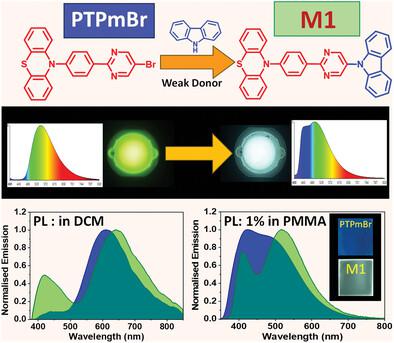当前位置:
X-MOL 学术
›
Adv. Opt. Mater.
›
论文详情
Our official English website, www.x-mol.net, welcomes your feedback! (Note: you will need to create a separate account there.)
Intriguing Role of Weak Electron Donor in Dictating the Luminescent Characteristics of DS‐A‐DW Materials
Advanced Optical Materials ( IF 9 ) Pub Date : 2024-04-09 , DOI: 10.1002/adom.202302789 Jianbin Xu 1, 2 , Mei Chen 3 , Paramaguru Ganesan 1, 2 , Xuejing Liu 4 , Zilong Zhang 1, 2 , Yanrui Liu 1, 2 , Baohua Zhang 3 , Peng Gao 1, 2, 5
Advanced Optical Materials ( IF 9 ) Pub Date : 2024-04-09 , DOI: 10.1002/adom.202302789 Jianbin Xu 1, 2 , Mei Chen 3 , Paramaguru Ganesan 1, 2 , Xuejing Liu 4 , Zilong Zhang 1, 2 , Yanrui Liu 1, 2 , Baohua Zhang 3 , Peng Gao 1, 2, 5
Affiliation

|
The short wavelength (SW) emission region of the materials employing strong donor (DS ) phenothiazine (PTZ) is generally correlated to its quasi‐axial (QAPTZ ) conformer arrangement. This propels to investigate the specific role of weak donors (DW ) such as carbazole (CZ) in determining the emission characteristics of molecular heredity (MH) type structural design encompassing dual donors of varying strength. For this purpose, a common DS (PTZ)–Acceptor unit is linked to the DW (CZ) unit via different linkage positions to form M1, M2, and M3, which not only alters the absorption and dual emission characteristics but also influences the delayed fluorescence phenomenon. The SW emission originates by minimizing the aggregation factor rather than by literature envisaged QAPTZ conformer. Incorporating M1 as a single molecular white light emitter (SMWLE) in near UV light emitting diode (LED) devices results in cold white light emission with CRI of 68 and CIE of (0.24, 0.33), while its corresponding solution‐processed organic light‐emitting diode devices delivers warm white electroluminescence with an EQE of 5.8%. Overall, this work demonstrates the significant contribution of the DW in attaining the white light emission characteristics of MH molecular design not only at the molecular level but also in practical light‐emitting devices.
中文翻译:

弱电子供体在决定 DS-A-DW 材料发光特性中的有趣作用
采用强施主(D)材料的短波长(SW)发射区域S )吩噻嗪(PTZ)通常与其准轴(QA云台 ) 构象排列。这推动了研究弱捐助者的具体作用(D瓦 ),例如咔唑(CZ),用于确定包含不同强度的双供体的分子遗传(MH)型结构设计的发射特征。为此,一个共同的 DS (PTZ) – 接收器单元连接至 D瓦 (CZ)单元通过不同的连接位置形成M1、M2和M3,这不仅改变了吸收和双发射特性,而且影响了延迟荧光现象。 SW 发射源自最小化聚合因子,而不是文献设想的 QA云台 构象者。将 M1 作为单分子白光发射器 (SMWLE) 纳入近紫外发光二极管 (LED) 器件中,可产生冷白光发射,CRI 为 68,CIE 为 (0.24, 0.33),而其相应的溶液处理有机发光体发光二极管器件可发出暖白色电致发光,EQE 为 5.8%。总的来说,这项工作展示了 D 的重大贡献瓦 不仅在分子水平上而且在实际发光器件中实现MH分子设计的白光发射特性。
更新日期:2024-04-09
中文翻译:

弱电子供体在决定 DS-A-DW 材料发光特性中的有趣作用
采用强施主(D)材料的短波长(SW)发射区域



























 京公网安备 11010802027423号
京公网安备 11010802027423号